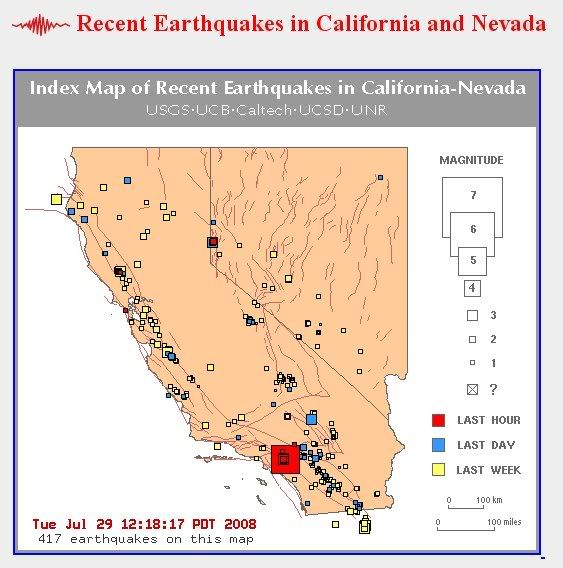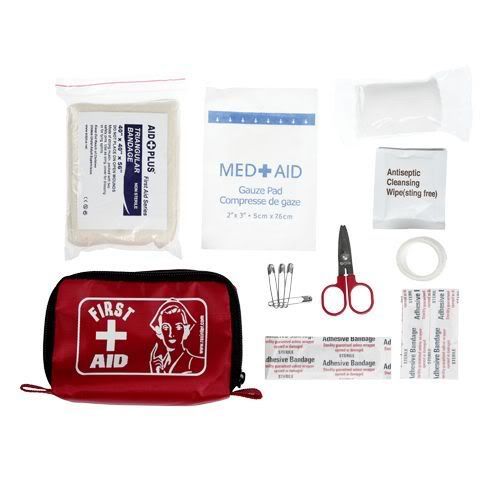
For those of you living in Southern California, what happened yesterday may be familiar to some and very new to others. A 5.4 magnitude earthquake struck just northeast of downtown Los Angeles yesterday morning around 11:45 a.m.
I was sewing in my family room while my daughter was reading next to me. She is 16 and was only 2 years old when the Northridge earthquake struck so this was very new to her.
The earthquake reminded me of something I've been working on for the last few months - something that should be complete and ready at all times - the earthquake kit.
It's been 14 years since the last big quake here in Los Angeles and we all tend to get complacent about disasters over time. However, being prepared for a natural disaster is very important so I'll be giving you some basic recommendations to refresh or start an earthquake kit in your own home.

Water:
The most important thing we can have in our homes is fresh, bottled water. I always replenish my stock of bottled water each time I go to the market I place them in the back of my water storage cabinet, using the older bottles first. I keep 10 one-gallon bottles in this cabinet at all times.
The recommendation is one gallon of water per day per person. Remember to store water for your pets as well - no one will be able to drink the tap water in the event of a major earthquake.
The alternative to storing bottled water is to store a bottle of regular household bleach. Do not use bleach with any scents or additives. The bleach can be used to purify tap water (okay, which would you prefer to drink - bottled water or water with bleach added). 16 drops of bleach per gallon of water is recommended - then let the water stand for 30 minutes. If the water does not have a slight odor of bleach at that time, repeat the process. Again, get the bottled water....

First Aid:
** Assorted sizes of sterile band-aids (bandages)
** Sterile gauze pads (various sizes)
** Bandage tape
** Safety pins
** Scissors
** Tweezers
** Medicine dropper
** Latex gloves (3-4 pairs)
** Neo-sporin
** Non-prescription pain relievers, antacid, anti-diarrhea medication, syrup
of ipecac
** Moistened toweletts
** Thermometer
** Purell or other hand sanitizer
** Sunscreen
Food:
** Cans of vegetables, meats & fish, fruits, beans
** Canned juices (vegetable, fruit), soup
** Parmalat or packaged soy milk
** Spices - sugar, salt & pepper
** High energy foods - crackers & peanut butter, trail mix, granola bars
** Vitamins
** Food for anyone in your family with special dietary needs
** Pet food
Remember to replace these foods once a year.
Sanitary Products:
** Toilet paper
** Paper towels
** Feminine supplies
** Toothbrushes and toothpaste
** Plastic garbage bags with ties
** Disinfectant
** Plastic garbage cans with lids
Clothing:
** Sturdy shoes/work boots (keep a pair of sturdy shoes under your bed
in case earthquake occurs at night - there may be broken glass on the floor)
** Warm clothing - sweaters, underwear, extra socks, sweatpants
** Sunglasses
** Rain gear
Miscellaneous:
** Cash ($100 in small bills for necessary purchases since ATM's
and computers may be down for a few days)
** Flashlights with extra batteries
** Portable radio with extra batteries
Replace batteries yearly as well
** Off or other insect repellant
** Non-electric can opener
** Plastic utensils, cups and plates
** Reading glasses
** Tent (you may have to sleep outside for a few days)
** Blankets
** Screwdriver, pliers and wrench for turning off gas and/or water meters
** Matches (keep in plastic, waterproof container)
** Aluminum foil
It is also important to have a safe place for your important documents and records. I will cover this in another blog next week.

No comments:
Post a Comment